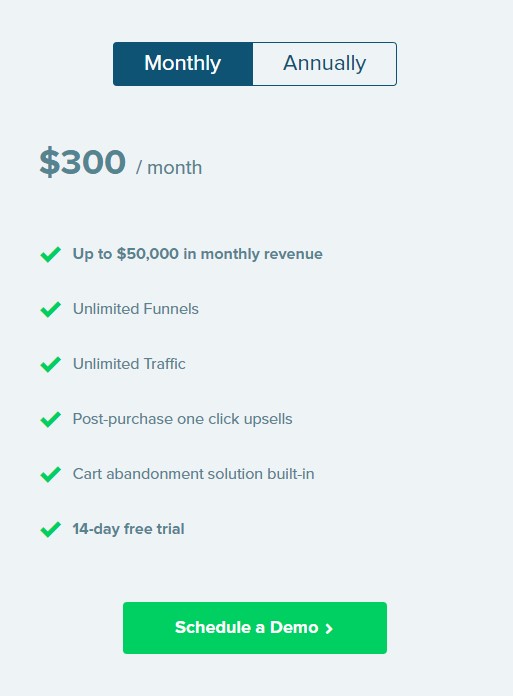It is a simple mathematical fact about enterprise software pricing models. A 1% increase in prices results in an 8% increase in the average company’s operating profits. (McKinsey, the Power of Pricing).
LinkedIn’s decided to package some seldom-used features as high-margin “premium” accounts. It spawned a business line that now makes almost $250 million a year. At eBay, listing the benefits of a low-cost tool made an impact. It meant the difference between profit and loss.
Most startups provide great innovation and value proposition to users. But many of them do not correctly assess their products’ value and price them accordingly. As a result, they struggle or fizzle out.
Monetization has 4 times higher efficiency than acquisition in getting growth. It is 2x more efficient than efforts to improve retention. A study of 512 SaaS companies proved this.
Setting a price for a product is one of the most critical decisions a company can make. But all too often, it is treated as an afterthought.
Startups usually set their price low to gain users. They never raise it or keep a feature free long after it is clear people will pay.
SaaS Revenues are Increasing Rapidly
The Gartner Group says that worldwide SaaS revenue will reach $22 billion by 2015. This is a 52% increase from 2012.
73% of firms indicated that nearly all their apps would be SaaS by 2020 (BetterCloud).
But the average SaaS startup spends just six hours on their pricing strategy. That is not six hours a week, six hours a month. It is six hours, ever, to define, test, and optimize everything.
It is understandable. There is such an overwhelming number of pricing models, strategies, and tactics available. It gets difficult to know where to start.
An optimal pricing strategy is crucial to SaaS success. But it should not be that difficult.
Read on to learn how a more thoughtful approach to pricing can boost your company’s profits. It can increase customer satisfaction. It can help you discover popular product variations that you had not considered.
We will look at what is working for distinguished and unique SaaS companies. Learn the broader strokes of comparative value pricing to best practice pricing display.
The Top Enterprise Software Pricing Models
1. Flat-Rate Pricing Model
This method is probably the simplest way to sell a SaaS solution. You offer a single product at a single price. It has a single set of features.
So, flat rate pricing bears many similarities to the software licensing model. This model was used before cloud infrastructure existed. But this is with the added benefit of (usually) being billed monthly.
Examples Of Flat-Rate Pricing

There are not many examples of flat-rate pricing. But eCommerce SaaS CartHook still uses the practice.
A monthly price of $300 grants access to all features.
Pros Of Flat-Rate Pricing
- Easier to sell. It offers a single product at a single price. This makes it possible to focus every ounce of sales and marketing energy. It helps to sell a single, clearly-defined offer.
- Easier to communicate. SaaS pricing models can get complicated and quickly. But flat rate pricing is easy to understand.
Cons Of Flat-Rate Pricing
- Difficult to extract value from different users. Suppose you are targeting SMBs, and use an SMB-friendly pricing strategy. In that case, you will miss out on a fortune in revenue if any Enterprise companies decide to adopt your tool.
- One-shot at securing customers. There is no nuance or flex in flat-rate pricing. Either would-be customers want the package, or they do not. There is not much you can do to sway them.
2. Usage Based Pricing Model
Also known as the Pay as You Go model, this pricing strategy directly relates the cost of a SaaS product to its users. If you use more of the service, your bill goes up; you useless, and your spending decreases.
It is common within infrastructure- and platform-related software companies. This includes Amazon Web Services. The firms are charged based on the number of API requests or transactions processed. It can also be based on the gigabytes of data used.
SaaS companies are increasingly finding new ways to adapt to the model. These include social media tools that charge for scheduled posts. It can also be an accounting tool that charges per invoice.
Examples Of Usage Based Pricing

This method works well for recurring billing platforms like Chargify. It directly correlates price with revenue. You can guarantee that price increases only happen alongside increased revenue periods. This ensures that customers will always be able to afford and justify the price change:
Pros Of Usage Based Pricing
- Price scales alongside usage. It makes sense to correlate usage and price. You may have volatile demand and use less of a service in a given month. Then why should you expect to pay the same amount as a boom month?
- Reduces barriers to use. There are no high up-front costs with usage-based pricing. Even small startups can get started with your product. They feel safe knowing that prices will only increase alongside their usage.
- Accounts for “heavy user costs.” With fixed-price packages, there is always a risk. “Heavy” users can take up a disproportionate amount of your delivery resource. It will happen without them compensating for it with increased spending.
Cons Of Usage Based Pricing
- Disconnects value from the product. Do your users care about the number of API requests they generate? Or do they want seamless integration of two crucial pieces of software?
- Harder to predict revenue. Billing amounts will vary month-to-month. It makes it much harder to forecast revenue.
- Harder to predict customer costs. The same problem applies to customers. Those with volatile usage may see unexpected fluctuations in their monthly bills.
3. Tiered Pricing Strategy
Tiered pricing is the de facto model used in mainstream SaaS. At its heart, tiered pricing allows companies to offer many “packages.” They can have different combinations of features offered at different price points.
The number of packages on offer can vary. But the average clocks in 3.5. It is often geared towards low, middle, and high price points.
Tiered Pricing Example

SaaS content marketing company HubSpot employs tiered pricing to a significant effect.
Each tier is created around the needs of different users. This ranges from marketing teams to those new to Inbound marketing.
Pros Of Price Tiering
- Appeal to many personas. With a single package, you have one shot at resonating with your target customer. With tiered pricing, you can tailor packages to suit many buyer personas.
- Leave less money on the table. You can appeal to many personas. Thus, you can maximize the revenue generated from different customer types. Offering a $100 tier will overcharge users with a $10 willingness to pay. It will undercharge users willing to spend $200.
- Clear upselling route. Your customer may outgrow their current package. But there is a direct route to the next price point.
Cons Of Price Tiering
- Potentially confusing. Choices can quickly become overwhelming. Trying to choose between ten price tiers may lead to an abandoned sale.
- Appeals to too many people. It is tempting to create a wide range of packages to appeal to every possible need. But as the adage goes, you cannot be everything to everyone.
- Heavy user risk. The top tier users usually exceed their allocated service usage. You have no way of collecting extra revenue to compensate.
4. Per User Pricing Model
Spend a few minutes browsing pricing pages, and you will come away with an impression. Per-User Pricing is the go-to SaaS pricing model.
Pacific Crest’s annual SaaS survey backs-up these findings. Per-user pricing was the most popular pricing model.

This popularity can largely be attributed to simplicity. A single user pays a fixed monthly price. When another user is added, that price doubles. Adding a third user trebles the monthly cost.
This makes it easy for users to understand what their monthly subscription buys them. It is easy for SaaS startups to manage and predict their revenue.
Per User Pricing Example

Look no further than road-mapping SaaS ProductPlan for an archetypal use case. The only variable is the users added to the account.
The per use price is the same, whether you are a single user or a team of 100.
Pros Of Per User Pricing
- Simplicity. It is one of the most direct pricing models. This makes it easy for would-be customers to calculate monthly costs. Thus, it is excellent for users and great for simplifying the sales process.
- Revenue scales with adoption. You may double the number of users within a firm. Then you will be rewarded with double the revenue.
- Predictable revenue generation. SaaS companies rely on the recurring revenue model. You can easily forecast each month’s revenue generation.
Cons Of Per User Pricing
- It limits adoption. People avoid adding new users to the tool. This also provides an incentive to cheat. People try to share a single login.
- It makes it easy to churn. By limiting adoption, you also make it easier for customers to abandon your service. After all, who is more likely to churn? A team of 10 people using your service, or a team of 100?
- It does not reflect the real value. Does it make a difference to a customer whether they have got three users or four?
5. Per Active User Pricing
Active user pricing is a variation of the per-user model. Many SaaS companies encourage yearly billing cycles. A new user could pay for hundreds of employees up-front. This is without any guarantee that those employees would use the software.
Per active user pricing tackles this problem head-on. It encourages customers to sign-up as many users as possible. It helps to safeguard that only active users will be billed for.
Per Active User Pricing Example

Slack is a prominent example of this pricing model.
You may add any number users you want. You will only be charged for using the software.
Pros Of Per Active User Pricing
- Customers only pay for active users. This means no money is wasted on unused seats: customers only pay for what they use.
- Reduces the risk of widespread adoption. If you are selling into an enterprise company, you want to encourage as much adoption as possible. Per active users, the pricing makes it easier.
Companies can take risks and initiate a company-wide roll-out. They do not pay if it does not work.
Cons Of Per Active User Pricing
- Does not work so well for SMBs. This pricing model works great for improving enterprise organizations’ adoption.
But cash may be tight, and team sizes are small. Then per active user and pricing does not offer much extra incentive to bite the bullet.
6. Per Feature Pricing
For the previous two SaaS pricing models, users were the standard variable. But, it is entirely possible to use features as your value metric instead.
Per feature pricing separates different pricing tiers according to the functionality available. The higher-priced packages are associated with a more significant number of features.
Per Feature Pricing Example

The differentiator between Evernote’s Basic, Plus, and Premium packages is different features. New functionality is “unlocked” with each upgrade.
Pros Of Per Feature Pricing
- Strong upgrade incentive. It gives an obvious motivation for upgrading. You unlock extra functionality.
- Compensate for delivery-heavy features. Some of your features may need a disproportionate amount of resources to deliver. Per feature pricing allows you to put these features in top-tier packages.
Cons Of Per Feature Pricing
- Difficult to get right. Getting the balance wrong can discourage adoption. Crucial features end up in overpriced tiers. Most of the product’s benefit ends up in the cheapest package.
- Leaves a sour taste. It is easy to feel resentful with per feature pricing: you are paying a monthly fee to use a product. Still, you are missing out on some of their functionality.
7. Freemium Business Model
Thanks to Slack, Evernote, and Dropbox, many SaaS companies use freemium pricing. They offer a free-to-use product, supplemented by extra paid packages.
The freemium model is used as part of a tiered strategy. The paid packs are supplemented with a free, entry-level tier.
That tier is then limited across specific dimensions. This encourages users to upgrade at a certain level of usage. It typically uses the following:
- Feature-based limitations. You need a paid package if you want X feature.
- Capacity-based limitations (if you exceed your allowance, you will need a paid package)
- Use-case limitations. You can use the free package internally. But it cannot be used for managing customers.
Example Of Freemium Pricing

Live chat SaaS Drift uses freemium pricing to a significant effect.
Their “Free” package lets small firms to talk to their first 100 contacts. Demand for the service may increase beyond that point.
It will most likely correlate with company and revenue growth. Then it becomes necessary to upgrade to their paid packages.
Pros Of Freemium Pricing
- It is a foot in the door. The biggest challenge of SaaS firms is usually initial adoption. This model makes it easy for users to get started with your product.
- Viral potential. There is great viral potential with such low barriers to use. Companies like Dropbox snowballed because of user referrals. Their users passed on the product to acquaintances.
Cons Of Freemium Pricing
- Freemium is a real revenue killer. Free users do not generate any revenue for your company. Your paid users need to generate enough revenue. It will help to support the cost of acquiring and serving all your users – paid and free.
- It is easier to churn on a free package. Widespread adoption is made simple by a free-to-use version of your SaaS product. But users may adopt a throwaway mentality. This increases churn as a result.
- It can devalue your core service. Suppose your product solves a painful, expensive problem for free. In that case, your users may resent having to pay for the service eventually.
Key lessons learned from these pricing models
Gathering these SaaS pricing examples made us realize the following:
- Charge based on value. It is an excellent way to calculate value down to the details and charge it if you feel lost. Think about a tool you like and how much you would be willing to pay for it, and why. Apply that to your service.
- Focus on customers that you provide value for and not wrong fit customers.
- Free plans can work as you can gain users over time. But it depends on server and support costs.
- If you are going to increase pricing, then say it to them straight.
- It is ok to experiment with pricing. Experiment faster.
How to Choose The Right Pricing Model
-
Trial and error
Play with prices. Founders and managers focus too much on pricing schemes that they knew from previous jobs or accepted by the first customers. They rarely “play,” i.e., test and change pricing strategies.
This is a must in the first year of launch. After that period, I recommend that the management (including sales and marketing) review and adjust it accordingly at least once a year.
-
Incentive schemes should reflect pricing models
If incentive schemes for marketing and sales teams are not adjusted to the product pricing conditions, motivation and sales rates will decrease.
After pricing changes, amendments to bonus regulations are often forgotten.
-
Losing customers is natural
It is not a shame to let a user walk away because of pricing. Founders and managers often reduce pricing at the beginning of a product life cycle to acquire customers’ long tail.
However, pricing reflects the quality. In the enterprise space, it is vital to show this to customers. This is also a vital message to sales managers.
-
Cash flow is vital for start-ups
Try to find a pricing model that incentivizes upfront payments. As a SaaS company, it is in particular essential to focus on it.
Otherwise, you will have to raise more money to finance sales and marketing in advance before receiving a positive cash flow from customers.
-
Cash flow might also be necessary to customers
Be flexible on the payment terms for current users.
Extending an existing contract or upselling an extra feature typically comes at a much lower CAC than closing a new customer.
This should not be a standard procedure, but it might be necessary for some instances.
-
Never do pilots or proof of concepts for free
Some large corporations love testing software for free. Their employees often have little to do.
If there is a designated budget available within an organization, a software solution is licensing is probable.
Do not waste too much time on demos. You should convince a customer beforehand that your product is worth trying it with some money coming back to you.
-
Price carefully. Always expect a discount
Instead, go into pricing negotiations with a little too high pricing than the other way around. Even with tenders, there is a lot of price negotiation.
Moreover, an enterprise sales process with high annual contract values at a particular stage almost always involves the friendly people of the procurement department.
Expect that you have to give at least 10–20% (in some industries even much higher) discounts on your quote as an incentive to your customer’s procurement guys.
-
Do not disclose your entire enterprise pricing on your website
This learning is not related to competition. Your competitors will eventually find out your pricing. This is somewhat related to your customers.
Budgets are different depending on the size of the company, the functional department, and the industry.
Moreover, some customers will negotiate better than others. Therefore, keep them away from public price lists. You will be in contact with users anyway. This is because you operate in the enterprise space.
However, there is one reason why communicating the price for your product/software with the least features available (=the lower boundary) can make sense.
Suppose you position yourself in the high-quality high-price segment and show your lowest price tag.
In that case, you prevent customers with much less budget available from distracting your sales managers.
-
Clusters within pricing schemes
Develop pricing schemes for internal use and training of salespeople. Cluster prices according to customer segments and sales experience. This might include clustering according to
- Type – corporates, academic, government
- Region and size – enterprises, SMEs etc.
- Functional departments – e.g., collaboration software used from marketing via sales until Customer success
- Upselling Potential
- Industry etc
-
Set your pricing according to the user’s needs
This is one of the most relevant but trickiest learning. The better you know the customer’s need and ROI benefiting from your software, the better you can stage your product pricing.
This task can only be achieved by gaining insights into existing customers. Your customer success team typically accomplishes this task.
But be aware, the ROI of your customer can significantly differ between regions (in terms of labor costs) or industries.
-
Do not reinvent the wheel
Try different business models. But never bet only on new pricing that customers are not used to.
I give you an example: if, within your industry, it is commonly accepted that you price a software product per seat every month, do not start to try to sell it on a per-usage basis.
But, test new business models with designated customer peer groups.
-
Keep pricing schemes simple
Even if you serve different customer groups, start with a simple, e.g., 3×3 pricing matrix, features, and consumers (accounts or seats). You can adjust it over time.
However, keep in mind that the simpler the pricing scheme is, the easier it is to align with sales managers’ incentive schemes.
-
Lock-in effect is important
Consider the ROI for the user when you think about pricing. Try to generate a high lock-in effect.
This includes a single user’s activity (which is hardly influenced by pricing but rather the quality of your product) and how many people within the different departments use your product.
Your pricing strategy can strongly influence the latter point.
Conclusion
As you proceed with your pricing strategy, routinely remind yourself of something. Your customers are analytical but prone to logic leaps. They want bargains. But they often base them on arbitrary reference points. Above all, they do not want to feel like they are on the hook if they make the wrong choices.
Suppose you can manage these desires. You manage it while providing a product that customers are eager to pay for. In that case, you will be on your way to building an enduring business.








